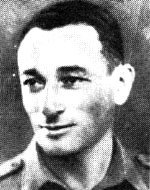Son of Sarah and Shmuel. He was born on December 6, 1912, in the town of Cachwarde, Hungary, a descendant of a family of rabbis. His father was a military rabbi in World War I, was captured by the Russians and died in captivity. Dov was educated at his grandparents’ home, studied first at the yeshiva and then went to study engineering at the Technion in Czechoslovakia, but only managed to study there for two years. Upon the Nazi invasion of Czechoslovakia he returned to Hungary and in the capital Budapest he worked as an assistant engineer in an electrical factory. Upon his return to Hungary, he joined the Betar movement and was appointed in charge of a instructors’ course, and in 1939 he invested most of his energies in organizing a group of immigrants from his movement and in 1940 arrived in Eretz Israel on the illegal ship “Skaria.” The ship was spotted by a British warship Were arrested and transferred to the detention camp at Atlit, where they spent six months, and joined the Irgun’s enlistment unit in Rosh Pina, where he joined the Irgun.In 1941 he joined the infantry company (” ) In the British Army where he served for more than five years. In his service he showed exemplary devotion and courage, while continuing to study electrical engineering through the British Institute. The army was active in the struggle for the flag and the Hebrew insignia, a problem that was partly solved with the establishment of the Jewish Brigade. In the ranks of the Jewish Brigade he participated in the war front in Italy and after the end of the war, he met with survivors of the extermination camps in Europe. “I was astonished when I saw so much delicacy in the Lev of a Jew who suffered from the Nazis in the most difficult systems in which the British army participated. “After his discharge from the army, Dov immediately joined the Irgun underground and took part in two combat operations: first by confiscating weapons from a military camp in Netanya and then by attacking the Ramat Gan police fortress, garden. In the attack on the fortress, which took place on April 23, 1946, he was the commander of the “porters” unit, whose job it was to remove the weapons and load them from under heavy fire. He and his men managed to empty the warehouse, but in the meantime police reinforcements from Petah Tikva arrived and gave the signal for withdrawal. Nevertheless, the “porters” continued to plant the weapons in cars. When Dov left the fortress he was hit by a bullet in his jaw, fell into a ditch and was captured by the British. He was transferred to Hadassah Hospital in critical condition and underwent surgery. After a while he was transferred to a government hospital in Jaffa, then to the central prison in Jaffa and in December 1946 to the Latrun detention camp. On January 1, 1947, Dov Gruner was put on trial but did not recognize the authority of the military court to sentence him. He declared a political declaration: “… that you must know: To cut off his hand will be cut off and the curse of God will be on him forever. ” For 105 days Dov was in the death row, and all the while there was a struggle to save his life. The strength of Dov was now the subject of worldwide interest, and many personalities and institutions were active in rescinding the verdict.the courage and strength of the wounded youngster who clung to his faith were the symbol of the human war to freedom with his people. “Dov Gruner is the problem of the Land of Israel. All the fanaticism, hostility, ideology, pain and suffering are folded in this shattered shape of a man who waited to die in the central prison. about”His organization planned to smuggle him out of jail in Jerusalem, but on the morning on which the smuggling was scheduled to take place, he and three other defendants – Elkhi, Dresner and Kashani – were transferred to the Acre fortress. On April 16, 1947, the four were taken to the gallows in the middle of the night without being allowed to part from their families, and Dov wrote to Menachem Begin, commander of the Etzel: “… I swear that if I had the choice to start over, In the same way I went without considering the possible consequences for me. ” Dov and his three friends wanted to be buried in Rosh Pina next to the grave of Shlomo son of Yosef, the king who was taken to the gallows in June 1938, but the authorities did not respond to the request and transferred their bodies for burial in Safed. In May 1954, a monument commemorating Dov Gruner was unveiled in Ramat Gan by sculptor Chana Orloff. The monument is in the form of a lions’ Aryeh whose nails are stuck in the Lev of the British Aryeh and pushed back. His name was immortalized in “Memories of Netzach,” the memorial book for fallen soldiers of the Irgun Zvai Leumi, in the book “Olei Hagardom”, and more.
